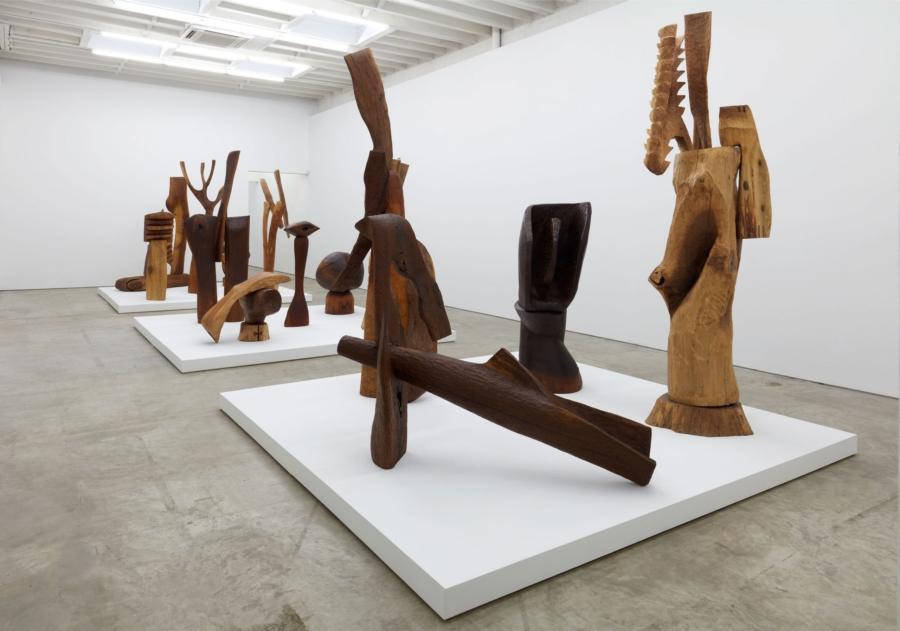January 11, 2021
Download as PDF
View on Sculpture Magazine

Thaddeus Mosley, installation view of “Thaddeus Mosley,” 2020.
Still making work at the age of 94, self-taught sculptor Thaddeus Mosley serves as an outstanding example of why Black Lives Matter. Although well known in the Pittsburgh area, where he has been exhibiting since 1959, his work has only recently gained a broader audience, due in part to his inclusion in the 2018 Carnegie International. Despite this recognition, Mosley’s sculptures are not part of the Whitney or MoMA collections, and this recent exhibition was only his second show in New York, following one in 2004 at the CUE Art Foundation.
Mosley works primarily with hardwood salvaged from local forests and sawmills (in this show, mostly walnut and cherry) that he combines in some sculptures with scavenged metal. Using chisels and other hand tools, he shapes and refines these repurposed materials, revealing through his process each element’s sensuous, tactile materiality and underlying organic abstraction. Two early pieces in the show reveal the expressive potential of this juxtaposition of the familiar and abstract. In Region in Suspension (1996), two walnut logs sliced by a slender wooden shaft reference the act of splitting wood, while another viewpoint reveals the curving lower limbs of a female torso. Propelled Simulation (2001)—two overlaid pieces of walnut suspended above a railroad switch and counterbalanced by a piece of sandstone—combines simple materials into an asymmetrical assemblage that evokes harmonic stasis and soaring movement.
Most of the 23 works on view were gathered in groups and placed on low platforms, forming ensembles that encouraged intimate observation and dialogues between the pieces. Inspired by jazz, with its accent on polyrhythm and syncopation, Mosley joins the disparate elements of his sculptures into subtly poised and, at times, precarious arrangements that, in works like Cross Current (2014) and Inclination (2003), suggest the give and take of improvisation or the extended riff of a solo performance.
While each of Mosley’s pieces is unique and original, together they call to mind a range of sculptural narratives, from the Modernist abstraction of Constantin Brancusi, Isamu Noguchi, and Barbara Hepworth and the counter-narrative of Black abstraction in the work of Joe Overstreet, Jack Whitten, and Martin Puryear to the performative, ceremonial, and spiritual aspirations of African tribal art. Yet, even as Mosley’s work testifies to his respect for artists and traditions, his adroit fusion of many sculptural languages also speaks to the creolization of the African diaspora in jazz and the Modernist avant-garde.
Mosley’s polyphonic response to these overlapping discourses could be seen throughout the exhibition. Totem for Nabta Playa (2016), with its curved, overlapping sheaves of walnut carved with lines and symbols, pays homage to the elongated stepladders of the Dogon people of Mali, Kongo cosmograms, and the monumental carvings of the Indigenous First Nations of the Pacific Northwest, articulating shared ancestries and sacred mythologies. Likewise, the untitled, stool-like pieces accompanying the bench-like Geometric Plateau (2014) form a ceremonial gathering, highlighting the spiritual aspect of Mosley’s work. Other works, such as the mythic, bird-like Masked Extension (2011), the masked, talismanic figure of Spatial Occupation (2018), the dung-shaped oval mound of Oval Continuity (2017), the lyrical Inverted Dancer (2007), and the dynamic interplay of Curved Suspend (2013) and Directional (2015), move away from the formalism of Western sculptural tradition to emphasize the mythological and sacred. Immersion in Mosley’s magical forest invites the pleasure of the experiential, sensual, and performative as it moves viewers from contemplation of material surfaces to the sublime.



